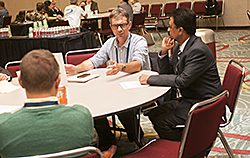
A participant (center) asks session leader Jess W. Brallier, M.D. (left), a question during a discussion of deep brain simulation.
Monitored anesthesia care is an everyday affair at many hospitals. But when sedation is needed to place electrodes for deep brain stimulation (DBS), the case can become more complicated.
“We are seeing more deep brain stimulation than ever before,” said Jess W. Brallier, M.D., Assistant Professor of Anesthesiology, The Icahn School of Medicine at Mount Sinai. “About 65 or 70 percent is for Parkinson’s disease and dystonia, but psychiatric indications are on the rise. We are seeing patients with depression, Tourette’s and other conditions that can requrie special attention.”
Dr. Brallier led a Problem-Based Learning Discussion, “Deep Brain Stimulation for Parkinson’s Disease: Just Another Simple MAC Case, Right?” on Monday. Neurosurgeons often administer their own local anesthesia to the pin sites when placing a neurosurgical head frame, but additional anesthesia falls to the anesthesiologist.
DBS involves implantation of stimulatory electrodes, or leads, in the thalamus, globus pallidus and other regions of the brain. Electrodes are usually placed bilaterally using MRI or CT to localize the target areas. Neurosurgeons drill burr holes through the skull, insert the leads and precisely locate the leads using intraoperative microelectrode recordings, or MER.
Once the leads are placed, patients are sent home for healing, then brought back for a second surgery to insert generators and attach the leads. Generator insertion is usually performed under general anesthesia.
The immediate complication with DBS is the need for different levels of sedation during different portions of what can be a long, exhausting procedure to place leads, Dr. Brallier said. Patients may need some degree of movement control during imaging to limit image artifacts induced by tremors. They need light to moderate sedation when burr holes are being drilled. But they must be alert, responsive and relatively drug-free while surgeons place stimulator leads.
They also may need sedation during closing. And for Parkinson’s patients, who were instructed to not take medications the day of surgery, it is important to get them back on their standard medication regimen as early as possible in the PACU.
Not all patients need help controlling tremors during imaging. Extreme tremor may require muscle relaxants and a general anesthetic, but agents such as fentanyl and propofol are usually effective. It may also help to strap patients to the imaging table to limit movement.
A scalp nerve block is the classic method of analgesia for awake craniotomy.
“This really is the most useful anesthesia for DBS,” Dr. Brallier said. “It has become part of our protocol for DBS. If you have a good scalp nerve block, patients can usually do very well on just dexmedetomidine and maybe propofol. If I’m using propofol, I turn it off when I hear the burr hole being drilled. The patient will be ready for MER when the surgeon is.”
The rate of intraoperative complications associated with DBS varies widely, he said. The most common problems include apnea, hypoxemia and hypercarbia related to deep sedation, and can usually be managed by lowering or terminating sedation or placing a supraglottic airway device. More complications include respiratory compromise, seizures, intracerebral hemorrhage and venous air embolism. There may also be cognitive complications with patients acting “goofy or funny” for a short time, but delirium is rare, Dr. Brallier said.
